ATG4B Rabbit mAb [419H]Cat NO.: A50977
Western blot(SDS PAGE) analysis of extracts from Ramos cells.Using ATG4BRabbit mAb [419H] at dilution of 1:1000 incubated at 4℃ over night.
Product information
Protein names :ATG4B,APG4B,AUTL1,KIAA0943,ATG4B_HUMAN,Cysteine protease ATG4B
UniProtID :Q9Y4P1
MASS(da) :44,294
MW(kDa) :47 kDa
Form :Liquid
Purification :Protein A purification
Host :Rabbit
Isotype :IgG
sensitivity :Endogenous
Reactivity :Human,Mouse
- ApplicationDilution
- 免疫印迹(WB)1:1000-2000
- The optimal dilutions should be determined by the end user
Specificity :Antibody is produced by immunizing animals with a synthetic peptide at the sequence of human ATG4B
Storage :Antibody store in 10 mM PBS, 0.5mg/ml BSA, 50% glycerol. Shipped at 4°C. Store at-20°C or -80°C. Products are valid for one natural year of receipt.Avoid repeated freeze / thaw cycles.
WB Positive detected :Ramos cells
Function : Cysteine protease that plays a key role in autophagy by mediating both proteolytic activation and delipidation of ATG8 family proteins (PubMed:15169837, PubMed:15187094, PubMed:17347651, PubMed:19322194, PubMed:21177865, PubMed:26378241, PubMed:29232556, PubMed:28821708, PubMed:30443548, PubMed:30661429, PubMed:22302004, PubMed:27527864, PubMed:28633005, PubMed:30076329). Required for canonical autophagy (macroautophagy), non-canonical autophagy as well as for mitophagy (PubMed:33773106, PubMed:33909989). The protease activity is required for proteolytic activation of ATG8 family proteins: cleaves the C-terminal amino acid of ATG8 proteins MAP1LC3A, MAP1LC3B, MAP1LC3C, GABARAPL1, GABARAPL2 and GABARAP, to reveal a C-terminal glycine (PubMed:15169837, PubMed:15187094, PubMed:17347651, PubMed:20818167, PubMed:19322194, PubMed:21177865, PubMed:22302004, PubMed:27527864, PubMed:28633005, PubMed:29458288, PubMed:30661429, PubMed:28287329). Exposure of the glycine at the C-terminus is essential for ATG8 proteins conjugation to phosphatidylethanolamine (PE) and insertion to membranes, which is necessary for autophagy (PubMed:15169837, PubMed:15187094, PubMed:17347651, PubMed:19322194, PubMed:21177865, PubMed:22302004). Protease activity is also required to counteract formation of high-molecular weight conjugates of ATG8 proteins (ATG8ylation): acts as a deubiquitinating-like enzyme that removes ATG8 conjugated to other proteins, such as ATG3 (PubMed:31315929, PubMed:33773106). In addition to the protease activity, also mediates delipidation of ATG8 family proteins (PubMed:15187094, PubMed:28633005, PubMed:29458288, PubMed:32686895, PubMed:33909989, PubMed:19322194). Catalyzes delipidation of PE-conjugated forms of ATG8 proteins during macroautophagy (PubMed:15187094, PubMed:29458288, PubMed:32686895, PubMed:33909989, PubMed:19322194). Also involved in non-canonical autophagy, a parallel pathway involving conjugation of ATG8 proteins to single membranes at endolysosomal compartments, by catalyzing delipidation of ATG8 proteins conjugated to phosphatidylserine (PS) (PubMed:33909989). Compared to other members of the family (ATG4A, ATG4C or ATG4C), constitutes the major protein for proteolytic activation of ATG8 proteins, while it displays weaker delipidation activity than other ATG4 paralogs (PubMed:29458288, PubMed:30661429). Involved in phagophore growth during mitophagy independently of its protease activity and of ATG8 proteins: acts by regulating ATG9A trafficking to mitochondria and promoting phagophore-endoplasmic reticulum contacts during the lipid transfer phase of mitophagy (PubMed:33773106)..
Subcellular locationi :Cytoplasm. Cytoplasm, cytosol. Cytoplasmic vesicle, autophagosome. Endoplasmic reticulum. Mitochondrion.
IMPORTANT: For western blots, incubate membrane with diluted primary antibody in 1% w/v BSA, 1X TBST at 4°C overnight.


